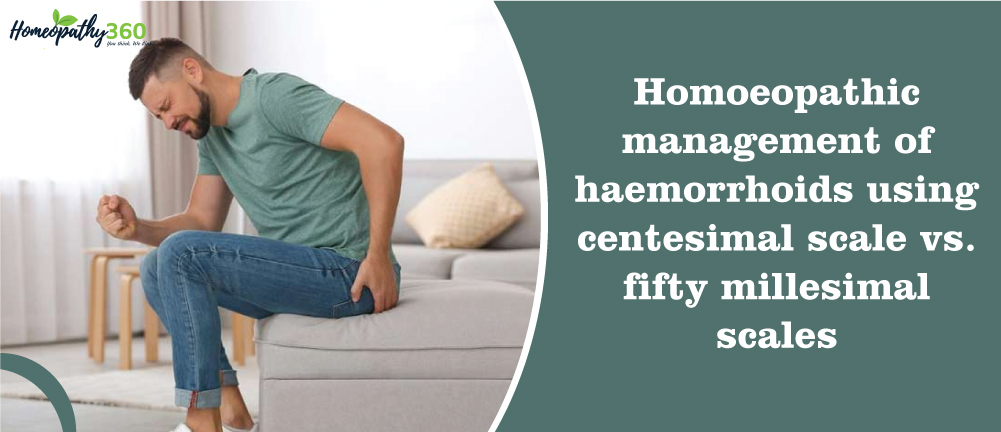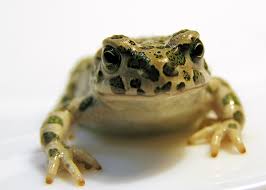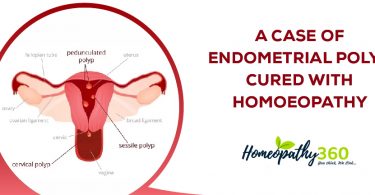
ABSTRACT-
Background– The pathological condition occurring at the ano-rectal region is called haemorrhoids, also known as piles. They consist of enlargement and distal displacement of the normal anal cushions causing venous dilatation and other troublesome symptoms. They are mostly seen in those individuals who do not follow a proper lifestyle, that is, those who indulge in excessive intake of junk, spicy food, and have less intake of water and dietary fibre resulting in altered bowel habits. The aim of this study is to treat the patients suffering from haemorrhoids and provide them relief and to evaluate the comparative effectiveness of dynamisation scales used in homoeopathy (centesimal scale and fifty millesimal scale) in patients suffering from haemorrhoids.
Materials and methods– Patients, both men and women between the age of 20-70 years, presenting with symptoms such as bleeding, pain, constipation, prolapse of pile mass, mucus discharge, itching and anaemia were included in the study which was a prospective observational study in which half the number of patients will be given Centesimal scale potency and the other half will be given fifty millesimal scale potency of homoeopathic medicines, with follow-ups every fortnight. Changes in the haemorrhoidal symptoms and VAS score were the main outcome measures.
Results– 30 patients were analysed. Unpaired t-test was used in this study. When centesimal scale and fifty millesimal scale of medicines were compared, fifty millesimal scale showed earlier improvement in haemorrhoids.
Conclusion– In this study, the findings are encouraging and show significant reduction in haemorrhoidal score and VAS scale after homoeopathic treatment having used both the scales (fifty millesimal and centesimal scales)but fifty millesimal scale potency showed significant and early improvement as compared to the patient who were given medicines in centesimal scale. However, larger sample size is required for further validating the result.
KEYWORDS– centesimal scale, fifty millesimal scale, haemorrhoids, homoeopathy
Abbreviations- visual analogue scale (VAS), outpatient department (OPD)
INTRODUCTION
The abnormal dilatation and distortion of the vascular channel, together with destructive changes in the supporting connective tissue within the anal cushion, is a paramount finding of haemorrhoidal disease. (1) Congestion occurs in the veins of the haemorrhoidal plexus and leads to varicosities within the lower rectum and the anus. Globally, the incidence ranges from 50-80% and in India; it affects around 75% of the population. (2)Its incidence can be seen at any age and in both genders equally. (3) Haemorrhoids affect millions of people around the world, and represent a major medical and socioeconomic problem. Haemorrhoid is a serious anal disease affecting global population which causes significant morbidity and imposes economic burden among the patients. (4)
Haemorrhoids may be internal or external, depending upon the position of the varicosity. If it is above the Hilton’s line, it is called internal haemorrhoid and if it is below the Hilton’s line, it is called external haemorrhoid. So, internal haemorrhoid is covered by mucous membrane whereas the external haemorrhoid is covered with skin. (5) Symptoms comprise of bleeding which is bright red and occurs during defaecation as ‘splash in the pan’. Very rarely, the bleeding may be sufficient to cause anaemia. Pain may result from congestion of pile masses below a hypertonic sphincter. In addition to the main symptoms of pain and prolapse, patients may complain of anal irritation with Itching, mucous discharge. (6)
Corns, cereals such as barley, maize and bajra(7), leafy vegetables such as spinach, methi, (8), fruits such as ripe papaya, apples, pears, mangoes, guavas are useful for patients suffering from constipation.(9)
Some studies were done previously on effectiveness of homoeopathy in treatment of haemorrhoids. International Journal of Pharmacy and Pharmaceutical Sciences (2011)– The following medicines were found effective in study conducted on haemorrhoidal subjects- Aesculus hippocastanum, Hamamelis, Azadirachat indica, Collinsonia canadensis, Aloe socotrina.(10)Asian Journal of Homoeopathy( 2012 )– A prospective study was carried out to ascertain the treatment effects of homoeopathic remedies in external piles. The following remedies indicated the therapeutic affinity- Aesculus hippocastanum, Aloe socotrina, Alumina, Arsenicum album, Collinsonia canadensis, Hamamelis, Muriaticum aceticum, Bryonia alba, Nitricum acidum, Nux vomica, Paeonia officinalis, Ratanhia peruviana, Sulphur, Kalium carbonicum. (11) IJRH( 2013)– 19 medicines were used to treat 140 haemorrhoidal patients in randomised homoeopathic group. They are mentioned in the descending order of their prescription: Phosphorus, Sulphur, Nux vomica, Nitricum acidum, Lycopodium clavatum, Arsenicum album, Pulsatilla pratensis, Ignatia amara, Aesculus hippocastanum, Carbo vegetabilis, Calcarea carbonica, Chamomilla , Fluoricum acidum, Natrum muriaticum, Aloe socotrina, Graphites, Kalium carbonicum, Lachesis mutus and Mercurius solubilis. (12) Journal of Intercultural Ethnopharmocology( 2016)-The most frequently prescribed medicines were Sulphur, Nux vomica, Calcarea phosphoricum, Natrum muriaticum, and Causticum. (13)
MATERIALS AND METHODS
Study design– The comparative study was a prospective observational study. Changes in the haemorrhoidal symptoms and VAS score were the main outcome measures.
Setting– This study was conducted in the OPD of Nehru Homoeopathic Medical College and hospital, Delhi. Sample size for the study was 30.
Inclusion criteria– Both men and women between the age of 20-70 years, presenting with symptoms such as bleeding, pain, constipation, prolapse of pile mass, mucus discharge, itching and anaemia.
Exclusion criteria-Prolapse of rectum and other conditions with similar clinical symptoms like fissure, fistula, anorectal abscess, malignancy, rectal polyps. Cases outside the prescribed age group, immune-compromised patients and pregnant women were also excluded.
STUDY INTERVENTION USING HAEMORRHOIDS QUESTIONNAIRE AND VAS SCORE
Out of 30 patients, 15 patients were given centesimal scale potency and the other 15 were given fifty millesimal scale potency of Homoeopathic medicines with follow-ups every fortnight. Total duration of study was one year.
The type of research is Quantitative research in which the outcome was analysed based on numerical values obtained through Haemorrhoids questionnaire and VAS score. These 2 parameters were used to judge numerically the effects of homoeopathic intervention by analysing the scores before and after the intervention.
After full case taking of the patients with clinical examination, assessment of haemorrhoids were done using questionnaire on haemorrhoids based on their symptoms with intensity; and VAS score which is related to degree of pain felt by patient. Then, the medicines and their potency were selected on the basis of homoeopathic principles. Also, dietary changes were recommended to the patients.
Repetition of medicines was based on severity of symptoms, overall constitutional reactions and susceptibility of patient. Follow up was aimed more or less 2 weeks of time from the period of active interference.
STATISTICAL ANALYSIS
Unpaired t-test was used to estimate the changes in haemorrhoidal symptoms based on a questionnaire and changes in VAS scoring over the period of 5-6 months after homoeopathic intervention. Mean and standard deviation were used to express variables. Comparison of means of differences in the outcome of fifty millesimal and centesimal scales after treatment was also done. P < 0.001 was highly significant.
RESULT
Some observations came up during the study of 30 patients, which can be summarised as the following:-
| PARAMETERS | OBSERVATIONS |
| Age group of maximum occurrence | 30-40 years |
| Number of patients having family history | 11 |
| Number of patients showing recurrence of haemorrhoids | 12 |
| Degree of constipation associated with haemorrhoids | 3+ ( severe degree) in 13 patients |
| Number of patients showing spicy food aggravation | 18 |
| Number of patients having less intake of water | 19 |
| Most effective medicines | Natrum muriaticum, Sulphur, Nux vomica |
| Most effective potency in centesimal scale | 200 |
| Most effective potency in 50 millesimal scale | 0/2 |
| Predominant miasm | Psoro-sycotic |
Pre- and post-treatment changes in haemorrhoidal and VAS scorings in patients with respect to fifty millesimal scale potency of homoeopathic medicines
| HAEMORRHOIDAL SCORE ( Before treatment) | HAEMORRHOIDAL SCORE ( After treatment) | Difference | VAS SCORE (Before treatment) | VAS SCORE (After treatment) | Difference |
| 11 | 5 | 6 | 9 | 5 | 4 |
| 10 | 5 | 5 | 7 | 2 | 5 |
| 12 | 2 | 10 | 10 | 1 | 9 |
| 11 | 4 | 7 | 9 | 2 | 7 |
| 13 | 6 | 7 | 10 | 5 | 5 |
| 16 | 12 | 4 | 10 | 8 | 2 |
| 13 | 5 | 8 | 8 | 1 | 7 |
| 15 | 6 | 9 | 10 | 1 | 9 |
| 11 | 5 | 6 | 8 | 4 | 4 |
| 14 | 7 | 7 | 10 | 5 | 5 |
| 11 | 5 | 6 | 9 | 2 | 7 |
| 8 | 3 | 5 | 8 | 5 | 3 |
| 13 | 6 | 7 | 9 | 1 | 8 |
| 14 | 5 | 9 | 8 | 2 | 6 |
| 13 | 5 | 8 | 9 | 2 | 7 |
| MEAN=12.33 | 5.40 | 6.93 | 8.93 | 3.06 | 5.87 |
The overall difference found the haemorrhoidal score in 6.93; that is, between the average score of 12.33 before treatment and 5.4 after treatment. Concerning the VAS score, the difference was found out to be 5.87; that is between 8.93 before treatment and 3.06 after treatment. The decrease in the scorings indicate the decreased intensity or relief in the symptoms of haemorrhoids, mostly itching, pain, bleeding and constipation.
Pre- and post-treatment changes in haemorrhoidal and VAS scorings in patients with respect to centesimal scale potency of homoeopathic medicines
| HAEMORRHOIDAL SCORE ( Before treatment) | HAEMORRHOIDAL SCORE ( After treatment) | Difference | VAS ( Before treatment) | VAS ( After treatment) | Difference |
| 13 | 7 | 6 | 9 | 2 | 7 |
| 12 | 8 | 4 | 9 | 7 | 2 |
| 16 | 9 | 7 | 10 | 5 | 5 |
| 13 | 8 | 5 | 9 | 6 | 3 |
| 12 | 7 | 5 | 8 | 5 | 3 |
| 14 | 12 | 2 | 9 | 7 | 2 |
| 13 | 10 | 3 | 9 | 7 | 2 |
| 15 | 12 | 3 | 10 | 6 | 4 |
| 14 | 10 | 4 | 9 | 7 | 2 |
| 11 | 5 | 6 | 9 | 4 | 5 |
| 13 | 10 | 3 | 8 | 6 | 2 |
| 10 | 5 | 5 | 8 | 4 | 4 |
| 13 | 4 | 9 | 9 | 3 | 6 |
| 17 | 11 | 6 | 8 | 4 | 4 |
| 11 | 9 | 2 | 8 | 5 | 3 |
| MEAN= 13.13 | 8.47 | 4.67 | 8.8 | 5.2 | 3.6 |
The overall difference found the Haemorrhoidal score in 4.67; that is, between the average score of 13.13 before treatment and 8.47 after treatment. Concerning the VAS score, the difference was found out to be 3.6; that is between 8.8 before treatment and 5.2 after treatment. The decrease in the scorings indicate the decreased intensity or relief in the symptoms of haemorrhoids, mostly itching, pain, bleeding and constipation.
With regards to Haemorrhoids questionnaire; on referring the t table, at degree of freedom 28, we find calculated value 1.70 at p=0.1 going towards calculated value 3.67 at p=0.001. Our calculated value 3.48 exceeds the value in the table (1.70 at p=0.1 and 2.76 at p=0.01), so the difference in our means is highly significant. Since the mean of difference in fifty millesimal scale is greater, that is, 6.93 is greater than 4.67 in centesimal scale, it could be interpreted as superior. Therefore, fifty millesimal scale shows more effectiveness than centesimal scale.
With regards to VAS scoring; on referring the t-table, at degree of freedom 28, we find calculated value 1.70 at p=0.1 going towards calculated value 3.67 at p=0.001. Our calculated value 3.39 exceeds the value in the table (1.70 at p=0.1 and 2.76 at p=0.01), so the difference in our means is highly significant. Since the mean of difference in 50 millesimal scale is greater, that is, 5.87 is greater than 3.6 in centesimal scale, it could be interpreted as superior.
CONCLUSION– Haemorrhoidal disease is the one of the causes of great discomfort to the humanity. This condition is mostly attributed to certain dietary and bowel habits and to some extent, the family history of the patient. If not treated on time, it may lead to certain complications such as thrombosis, gangrene, infections, etc. Previous studies showed that homoeopathy has a great role in the treatment of haemorrhoids. In this study, the findings are encouraging and show significant reduction in haemorrhoidal score and VAS scale after homoeopathic treatment, having used both the scales (fifty millesimal and centesimal scales). The decrease in the scorings in both the scales signifies increased relief or reduction in the intensity of the haemorrhoidal symptoms. But fifty millesimal scale potency showed significant and early improvement as compared to the patient who were given medicines in centesimal scale. However, larger sample size is required for further validating the result.
REFERENCES
1. Loder PB, Kamm MA, Nicholls RJ, Phillips RK, ‘Haemorrhoids: Pathology, Pathophysiology and Aetiology.’ Br J Surg. 1994; 81:946-954) ( Last Accessed on 21/07/2020)
2. Ali SA, Shoeb MFR. ‘Study of risk factors and clinical features of haemorrhoids’. IntSurg J. 2017; 4:1936-9 (Last Accessed on 21/07/2020)
3. Total health tips. Haemorrhoids.Kiva microfinance.( Last Accessed on 21/07/2020)
4. Tomiki Y, Ono S, Aoki J, Takahashi R, Sakamoto K. ‘Endoscopic sclerotherapy with aluminium potassium sulphate and tannic acid for internal haemorrhoids’. Endoscopy. 2014; 46:E114 (Last Accessed on 21/07/2020)
5. Das S, Chapter-‘Examination of a Rectal case’. ‘A Manual on Clinical Surgery’- 9th edition. Published by Dr Somen Das, 13, Old Mayors’ Court,Kolkata – 700 005.India. Pgs- 539-550.
6. Norman S Williams, Christopher J K Bulstrode and P Ronan O’Connell .Chapter- ‘The Anus and anal canal’. ‘Bailey and Love’s,Short Practice of Surgery’, 26th edition. Taylor & Francis Group, LLC.Pg-1251
7. Bhaishajyaratnavali, siddhipradahindi commentary by kavirajgovindassen, professor siddhinandan Mishra editor, chaukhambasurabharatiprakashashan, reprint 2011 adhyaya- 9 289 (Last Accessed on 4/03/2021)
8. Charaksamhita, Ayurveda Deepika commentary by Cakrapanidutta, PtYadavjiTrikamjiAcharya editor, Rastriya Sanskrit Samsasthan, Reprint 2006 (Last Accessed on 4/03/2021)
9. Dash B, ‘Herbal Medicine on constipation’, B Jain publishers, Reprint 2006, pg no-25 (Last Accessed on 4/03/2021)
10. Gami Bharat, ‘Haemorrhoids- A Common Ailment among Adults, Causes and Treatment: A Review’. ‘International Journal of Pharmacy and Pharmaceutical Sciences’ (May 2011), pg-5-12.
11. D’Souza Rosario Pascal, Principal, E B GadkariHom Med College and Hospital, Maharashtra; pg-29-37, Asian Journal of Homoeopathy (2012) (Last Assessed on 20/8/2018)
12. Chakraborty P S, CCRH, New Delhi, ‘Effect of Homoeopathic LM Potencies in acute attacks of Haemorrhoidal disease: A multicentric randomized single-blind placebo-controlled trial; pg- 72-80, IJRH ( 2013, vol 7, issue 2)
13. Das Kaushik Deb, Ghosh S, ‘Treatment of Haemorrhoids with Individualised Homoeopathy: An open observational pilot study Original research. pg- 335-342, Journal of Intercultural Ethnopharmocology(2016). DOI-10.5455/jice.20160608030224.
About the authors
Prof. (Dr) Neeraj Gupta1 M.D (Hom.), Irene B Thomas2
- Professor &Guide, PG Department of Organon of Medicine and Homoeopathic Philosophy, Nehru Homeopathic Medical College and Hospital, New Delhi
- Final Year MD (Hom.) Scholar in Organon of Medicine and Homoeopathic Philosophy, Nehru Homeopathic Medical College and Hospital, New Delhi





